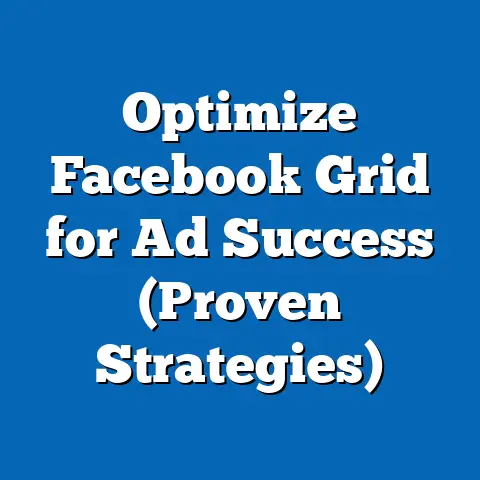Facebook Ads & Bikini Pics: Navigating the Guidelines (Essential Tips)
As a digital marketing specialist, I’ve witnessed firsthand the evolution of advertising, especially on platforms like Facebook. What was once a Wild West of unfiltered content has become a carefully curated landscape, governed by community standards and advertising policies. And rightfully so. Sustainable advertising, in my opinion, is about responsible marketing that respects both the audience and the platform. It’s about building trust, fostering genuine connections, and avoiding tactics that exploit or offend.
One of the most interesting intersections of advertising, ethics, and platform guidelines lies in the realm of fashion and swimwear. The trend of body positivity is finally gaining real traction, and brands are increasingly striving for diversity and authenticity in their campaigns. But how do you navigate the often-murky waters of Facebook’s advertising policies when your product is, well, bikinis? It’s a question I’ve helped numerous clients answer, and it’s a challenge that requires a delicate balance of creativity, compliance, and cultural sensitivity.
Understanding Facebook’s Advertising Policies
Facebook’s advertising policies are designed to create a safe and positive experience for its vast user base. These policies are not arbitrary; they’re a reflection of the platform’s commitment to fostering a respectful and inclusive community. As advertisers, it’s our responsibility to understand and adhere to these guidelines, even when they seem ambiguous or restrictive.
When it comes to nudity, adult content, and images of people in swimwear, Facebook maintains a relatively strict stance. While they don’t explicitly ban all bikini images, they do scrutinize ads that:
- Are sexually suggestive: This includes images that focus on specific body parts, portray people in overtly sexual poses, or imply sexual acts.
- Exploit, abuse, or endanger children: This is a zero-tolerance policy. Any ad that depicts or promotes child exploitation will be immediately rejected and reported.
- Promote products or services that are sexually explicit: This includes ads for adult toys, pornography, or escort services.
What’s Considered Acceptable?
Generally, ads that focus on the product itself (the bikini), rather than the model’s body, are more likely to be approved. Images that depict people enjoying themselves in a natural setting, such as a beach or poolside, are also generally acceptable, as long as they don’t cross the line into being sexually suggestive.
What’s Considered Unacceptable?
Ads that feature close-ups of cleavage, buttocks, or other body parts are almost always rejected. Similarly, ads that use provocative poses or suggestive language are likely to be flagged.
The Importance of Context
It’s crucial to understand that these guidelines are not set in stone. Facebook’s moderation algorithms and human reviewers take context into account. An ad that might be considered acceptable in one region or culture could be deemed offensive in another. For example, an ad featuring a modest bikini in a conservative country might still be rejected if it’s deemed to be culturally inappropriate.
My Experience:
I once worked with a swimwear brand that was launching a new line of modest swimwear designed for Muslim women. We were careful to adhere to Facebook’s guidelines, using images that showed the models fully clothed and focusing on the design and functionality of the swimwear. However, our initial ads were still rejected. After some back-and-forth with Facebook’s support team, we learned that the issue was the language we were using. We had used the term “modest swimwear,” which Facebook’s algorithms flagged as potentially discriminatory. We revised our ad copy to focus on the comfort and style of the swimwear, and our ads were subsequently approved.
Takeaway: Understanding Facebook’s advertising policies is an ongoing process. It requires careful attention to detail, cultural sensitivity, and a willingness to adapt your approach based on feedback from the platform.
Best Practices for Using Bikini Images in Ads
Now that we’ve covered the basics of Facebook’s advertising policies, let’s dive into some best practices for using bikini images in your ads. These tips are based on my experience working with numerous swimwear and fashion brands, and they’re designed to help you create effective campaigns that are both compliant and engaging.
Selecting the Right Imagery
The key to using bikini images effectively is to choose visuals that are high-quality, engaging, and product-focused. Here are some specific tips:
- Focus on the product: The bikini should be the star of the show. Choose images that showcase the design, fit, and features of the swimwear.
- Use natural settings: Images that depict people enjoying themselves in a natural setting, such as a beach or poolside, are generally more appealing and less likely to be flagged.
- Avoid objectification: Steer clear of images that focus on specific body parts or portray people in overtly sexual poses. Instead, choose images that celebrate the beauty and confidence of the model.
- Showcase diversity: Feature models of different shapes, sizes, and ethnicities to appeal to a wider audience and promote inclusivity.
- Use professional photography: Invest in high-quality photography that showcases your products in the best possible light.
Context Matters
The surrounding text and overall message of your ad should align with the imagery to create a cohesive narrative. Here are some tips:
- Highlight the benefits: Focus on the benefits of your swimwear, such as comfort, style, and durability.
- Tell a story: Use your ad copy to tell a story that resonates with your target audience. For example, you could share a story about a woman who feels confident and empowered in your swimwear.
- Use positive language: Avoid using language that is sexually suggestive or objectifying. Instead, use positive language that celebrates the beauty and confidence of women.
- Be authentic: Be true to your brand’s values and mission. Don’t try to be something you’re not.
Target Audience
Consider your target demographic and how bikini images may resonate differently across various audience segments. Here are some tips:
- Research your audience: Understand your target audience’s values, preferences, and cultural sensitivities.
- Segment your audience: Create different ad campaigns for different audience segments. For example, you could create one campaign for younger women who are looking for trendy swimwear and another campaign for older women who are looking for comfortable and supportive swimwear.
- Test your ads: Test different images and ad copy to see what resonates best with your target audience.
My Experience:
I once worked with a swimwear brand that was targeting a younger audience of college students. We used images that were trendy and playful, featuring models wearing brightly colored bikinis in fun, summery settings. However, we quickly realized that our ads were not performing well. After some research, we discovered that our target audience was more interested in sustainable and ethically made swimwear. We revised our campaign to focus on the brand’s commitment to sustainability, and our ads saw a significant improvement in engagement and conversions.
Takeaway: Understanding your target audience is crucial to creating effective Facebook ad campaigns. Take the time to research your audience’s values and preferences, and tailor your ads accordingly.
Crafting Compliant and Engaging Ad Copy
Ad copy is the unsung hero of Facebook advertising. It’s the voice of your brand, the storyteller that captivates your audience, and the bridge that connects your visuals to your message. When it comes to using bikini imagery, the ad copy becomes even more critical. It’s your opportunity to reinforce the positive message, highlight the product’s benefits, and ensure that your ad aligns with Facebook’s guidelines.
The Power of Positive Language
Ditch the clichés and embrace language that empowers, uplifts, and celebrates the beauty of the human form. Instead of focusing on unattainable ideals, highlight the comfort, style, and confidence that your swimwear provides.
Instead of: “Get beach-body ready!”
Try: “Feel confident and comfortable in your own skin with our new swimwear collection!”
Body Positivity and Inclusivity
Showcase models of different shapes, sizes, and ethnicities. This not only resonates with a wider audience but also demonstrates your brand’s commitment to inclusivity. Use ad copy that celebrates diversity and promotes body positivity.
Example: “Our swimwear is designed for every body. Find the perfect fit that makes you feel amazing!”
Conveying Your Brand’s Values
Your ad copy should reflect your brand’s values and mission. Are you committed to sustainability? Are you passionate about empowering women? Let your audience know!
Example: “We’re committed to creating sustainable swimwear that makes you look and feel good. Our new collection is made from recycled materials and designed to last.”
Avoiding Red Flags
Steer clear of language that could be interpreted as sexually suggestive or objectifying. This includes:
- Hyperbolic claims about weight loss or body transformation.
- Focusing on specific body parts.
- Using language that promotes unrealistic beauty standards.
The Importance of A/B Testing
Experiment with different ad copy variations to see what resonates best with your audience. Test different headlines, descriptions, and calls to action. Use Facebook’s A/B testing feature to track your results and optimize your campaigns.
My Experience:
I once worked with a swimwear brand that was struggling to get their ads approved. They were using images that were perfectly compliant, but their ad copy was consistently being flagged. After some investigation, we realized that the issue was the language they were using. They were using terms like “sexy” and “flattering,” which Facebook’s algorithms interpreted as potentially suggestive. We revised their ad copy to focus on the comfort, style, and durability of their swimwear, and their ads were immediately approved.
Takeaway: Your ad copy is just as important as your imagery. Use positive language, promote body positivity, and convey your brand’s values to create ads that are both compliant and engaging.
Case Studies and Real-World Examples
Let’s take a look at some real-world examples of brands that have successfully navigated Facebook’s guidelines while using bikini images in their advertising. We’ll also examine some cautionary tales of ads that faced rejection, detailing the reasons behind these outcomes.
Success Story: Aerie
Aerie, American Eagle’s lingerie and swimwear sub-brand, has built a loyal following by embracing body positivity and showcasing unretouched images of models of all shapes and sizes. Their Facebook ads are a testament to their commitment to inclusivity. They use images that are natural, authentic, and relatable, and their ad copy focuses on the comfort, style, and confidence that their products provide.
Key Takeaways:
- Authenticity: Aerie’s ads feel genuine and relatable, which resonates with their target audience.
- Inclusivity: They showcase models of all shapes and sizes, promoting body positivity and inclusivity.
- Product-focused: Their ads highlight the features and benefits of their products, rather than focusing on the models’ bodies.
Success Story: Frankies Bikinis
Frankies Bikinis is a popular swimwear brand that has mastered the art of using bikini images in their Facebook ads without crossing the line. They use high-quality photography that showcases their designs in a stylish and tasteful manner. Their ad copy is playful and engaging, and they often feature user-generated content, which adds a layer of authenticity to their campaigns.
Key Takeaways:
- Stylish Photography: Frankies Bikinis invests in high-quality photography that showcases their products in the best possible light.
- Engaging Ad Copy: Their ad copy is playful and engaging, capturing the brand’s personality.
- User-Generated Content: They leverage user-generated content to add authenticity to their campaigns.
Cautionary Tale: The Overly Suggestive Ad
I once encountered an ad for a smaller swimwear brand that pushed the boundaries of Facebook’s guidelines. The ad featured a close-up of a model’s cleavage, and the ad copy was overtly suggestive. Unsurprisingly, the ad was quickly rejected by Facebook. The brand appealed the decision, but their appeal was denied.
Key Takeaways:
- Avoid Close-Ups: Steer clear of images that focus on specific body parts.
- Use Appropriate Language: Avoid using language that is sexually suggestive or objectifying.
- Respect the Guidelines: Understand and respect Facebook’s advertising policies.
My Experience:
I’ve learned that sometimes, even when you think you’re being careful, your ads can still get rejected. It’s important to be prepared to appeal the decision and to provide additional information to support your case. In one instance, I had an ad rejected for “promoting adult content,” even though it was simply an image of a woman wearing a modest one-piece swimsuit. I appealed the decision, explaining that the ad was for a family-friendly swimwear brand and that the image was not sexually suggestive. After a few days, Facebook overturned their decision and approved the ad.
Takeaway: Learning from both successes and failures is crucial to mastering Facebook advertising. Pay attention to the ads that are performing well, and analyze the ads that are being rejected. Use this information to refine your approach and create campaigns that are both compliant and effective.
Conclusion
Navigating Facebook’s advertising guidelines when using bikini imagery can feel like walking a tightrope. But with a thorough understanding of the platform’s policies, a commitment to best practices, and a healthy dose of creativity, you can create impactful campaigns that resonate with your audience and drive results.
Remember to:
- Prioritize high-quality, product-focused imagery.
- Craft ad copy that is positive, empowering, and aligned with your brand’s values.
- Understand your target audience and tailor your ads accordingly.
- Stay up-to-date on Facebook’s advertising policies and be prepared to adapt your approach as needed.
By embracing the balance between creativity and responsibility, you can pave the way for a more inclusive and sustainable future in digital marketing.
Call to Action
Now I’d love to hear from you! Share your experiences with Facebook ads and bikini imagery in the comments below. What challenges have you faced? What strategies have worked well for you? Let’s foster a discussion about best practices and innovative approaches. You can also share your thoughts and experiences on social media using the hashtag #FacebookAdsBikini. Together, we can create a more responsible and effective advertising landscape.




